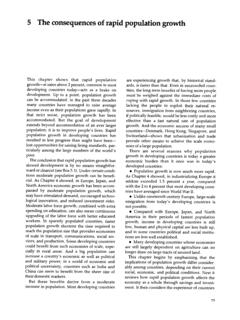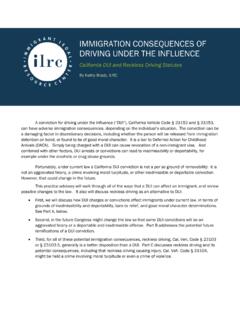Transcription of Irish Immigration to America, 1630 to 1921
1 Irish Immigration to america , 1630 to 1921 By Dr. Catherine B. Shannon Reprinted courtesy of the New Bedford Whaling Museum Introduction The oft quoted aphorism that "Boston is the next parish to Galway" highlights the long and close connections between Ireland and New England that extend as far back as the 1600s. Colonial birth, death, marriage, and some shipping records cite the presence of Irish born people as early as the 1630s. For instance, in 1655 the ship Goodfellow arrived in Boston carrying a group of indentured servants, and John Hancock's ancestor, Anthony Hancock, arrived from Co. Down in 1681. According to the story of The Irish Gift of 1676, which provided aid after King Phillip's War, Rev. Cotton Mather and Governor Winthrop corresponded with their Irish friends and relatives, with as many as 105 soldiers of Irish origin serving in various militias during the war. However, up until 1715, the numbers of Irish in New England were less than 1%, a small percentage of the The First Wave of Irish Immigration , 1715 to 1845 The first significant influx of Irish immigrants to Boston and New England consisted primarily of Ulster Presbyterians and began in the early eighteenth They comprised about ten percent, or 20,000 of a larger migration of over 200,000 Ulster Presbyterians who fled the north of Ireland to america between 1700 and 1775.
2 The majority arrived in Boston between 1714 and 1750, as most Ulster immigrants went to the mid-Atlantic area via Philadelphia, Baltimore, and Charleston beginning in the 1750s. Those who came to Boston between 1715 and 1740 were escaping the discrimination that the English Penal Laws imposed on Protestant dissenters (non-Anglicans) and Roman Catholics alike. They were also fleeing the consequences of a succession of poor harvests, droughts, escalating rents, and the burdensome tithe payments demanded by the established Anglican Church in Ireland. Revs. James McGregor, James Woodside, James McSpartan, and John Moorhead were among the twenty or so Presbyterian ministers who promoted emigration and led their congregations to america , not only because of their own poor economic situation, but also because the Test Act of 1704 had eliminated their legal standing to perform marriages, officiate at funerals, and hold any civil offices. The British government's cancellation of the annual Regium Donum paid to Presbyterian ministers, leaving many impoverished and searching for alternatives for themselves and their flocks.
3 External factors encouraging Immigration kicked in around 1718 when Massachusetts' Governor Samuel Shute agreed to allocate free land in the colony for Ulster settlers in response to the pleas of two Ulster ministers, Revs. Thomas Craighead and William Homes. Shute and the General Court agreed to provide land grants for Ulster settlers to reinforce the frontier against the Native Americans and to buttress Massachusetts' claim to the disputed territory of Maine, claimed by both Massachusetts and New Hampshire at the time. Others who encouraged Immigration were land speculators and sea captains such as Captain Robert Temple and Captain Robert Homes who were familiar with New England and who stood to gain from promoting migration from their native Ulster. In August 1718, a few months after Shute's land grant offer, a steady stream of ships arrived in Boston full of Ulster immigrants and additional vessels arrived over the next three years.
4 By 1720, as a result, approximately 2,600 Ulster immigrants had come to Boston. These immigrants were primarily from the Upper Ban Valley, the Foyle Valley, and the city of Londonderry. Thomas Lechmere, a Boston customs official, informed John Winthrop that the new arrivals were not servants, but " .. genuinely men of estates, and are come over hither for no other reason but upon encouragement sent from hence, upon notice given that they should have so many acres of land given to them gratis to settle our frontier as a barrier against the Indians."3 However, as more ships full of immigrants arrived in the midst of a poor harvest in 1718, Lechmere predicted that " .. these confounded Irish will eat us all up, provisions being most extravagantly dear and scarce." The following year, Governor Shute warned the General Court of the heavy burden the poor Irish were imposing on the Meanwhile, Boston s ordinary citizens were hostile to the Ulster newcomers since the city's dominant Congregationalists suspected all Irish people as enemies of the crown and considered them "unclean, unwholesome and disgusting," causing some Presbyterian ministers to complain that they were being mistaken for Papists.
5 Various city ordinances embodied the growing animus directed at the Irish . These legislative acts required Irish immigrants to register with town officials or post bonds within days of arrival, and if they failed to comply, they were "warned out" of the city, a fate that befell 300 Irish between 1714 and 1720, and another 49 from just one ship from the Northern Ireland in As a result of such hostility and persecution, many of these initial Ulster Irish ventured to Northern, Central, and Western New England where place names such Bangor, Belfast, and Limerick in Maine; Dublin and Londonderry in New Hampshire; and Hillsboro and Orange Counties in Vermont reflected their growing presence. Meanwhile, the few Catholics who came to Massachusetts faced laws that prohibited the practice of their religion and threatened their priests with life imprisonment or death if they were found in the Nonetheless, a series of recurring economic and subsistence crises in Ulster between 1728 and 1741 insured that New England would continue to receive immigrants from the north of Ireland until mid-century.
6 This Ulster outflow, combined with the start of small but regular emigration from Eastern and Southern Ireland, swelled the number of Irish immigrants arriving in Boston during the mid-1730s. It was against this background of nativist hostility, rising rates of emigration from Ireland, and a harsh and severe Boston winter in 1736-1737 that twenty-six men of Ulster birth founded the Charitable Irish Society of Boston. They pledged to provide aid to their fellow Irishmen who had been reduced to poverty by age, infirmity, sickness, shipwreck, or other misfortunes and also sought to cultivate a spirit of harmony among all resident Irishmen and their descendants and "to advance socially and morally the interests of the Irish people."7 The Society, celebrating its 280th anniversary in 2017, has continued to serve the needs of immigrants from Ireland down to the present Although the majority of Ulster eighteenth century immigrants funded their own passage costs of between 4 and 7 pounds sterling, a small number of immigrants from Ulster and other areas of Ireland came to the colonies as indentured servants whose passage was paid in return for four or five years of Given the dire conditions in their homeland, historian R.
7 Dickson observed: " .. servitude in hope of real freedom was preferable to the shackles of high rents and recurring depression: temporary bondage in heaven was preferable to a false freedom in hell."10 From 1750 to 1775, most Ulster immigrants went via Philadelphia, Baltimore, and Charleston to the Mid-Atlantic area in favor of greater land and employment opportunities in a region with less religious hostility than New England." The American Revolution temporarily halted Ulster Immigration to america , but it picked up again after 1783, fueled by unemployment and falling incomes caused by a severe decline in the linen trade in northeast Ulster. Meanwhile, agricultural expansion in Ireland during the Napoleonic Wars of 18oo and 1815 reduced the incentive for emigration among the agricultural classes of Leinster and Munster. Even though demand for Irish -grown grain dropped after the restoration of peace in 1815 and wages for Irish laborers declined, the spreading cultivation of the potato as the principal food source for the Irish country laborer postponed any massive outflow of immigrants from Munster, Leinster, and Connaught until the successive failures of the potato crop after Evidence demonstrates, however, a gradual rise in Irish Immigration to america from about 2,000 per year in 1820 to about 50,000 in Between 1836 and 1841, Boston received approximately 10,157 Irish immigrants, or just under 2,000 per year on the eve of the Immigration from the Famine Era to 1914 The Irish Potato Famine, beginning in 1845, caused a huge spike in emigration to america as people lost all hope in their ability to survive in Ireland owing to successive potato crop failures in the late 1840s, and the failure of the British government to provide timely and adequate relief measures.
8 The increase to 85,000 immigrants who fled from Irish ports in 1847 involved all classes and regions of the country and was exacerbated by the suspension of the government public works programs in the spring and the closing of the government run soup kitchens in the The Cork Examiner reported this panic driven exodus of 1847 as follows: "The emigrants of this year are not like those of former ones; they are now actually running away from fever and disease and hunger, with money scarcely sufficient to pay passage .. or food for the voyage."16 Evictions skyrocketed as insolvent tenants were forced off their lands by landlords attempting to consolidate their holdings to reduce their responsibility for paying the escalating poor rates caused by the 1847 Poor Law amendment that shifted the entire cost of relief from Westminster to local Irish rate-payers. A few landlords between 1846 and 1848 paid the passage costs of their tenants to go to america as a cost saving mechanism.
9 However, government and landlord assisted passengers numbered no more than 40,000, representing only a small percentage of the Irish men, women, and children who crossed the Atlantic between 1846 and The most bitter famine memories relate to the thousands who died on poorly organized landlord schemes to send immigrants to British North america with the loss of approximately 20,000 people who died on these "coffin ships" or shortly after their arrival at the Grosse Ile detention center in Quebec in the summer of Due to tighter maritime regulations on American ships in addition to a shorter journey time across the Atlantic, immigrants to the United States fared much better, as evidenced by higher survival rates. Famine refugees continued to flow into america in very high numbers between 1848 and 1853, reaching over 200,000 in 1851. Current estimates indicate that at least million emigrants left Ireland between 1846 and 1855, with the majority traveling to america .
10 Oscar Handlin cites the arrival of 121,381 passengers from Ireland to Boston from 1841 to 1851, and it is probable that a considerable number of the 22,777 who arrived from English and Scottish ports such as Liverpool and Glasgow were also While all these immigrants did not stay in Boston, they profoundly altered the ethnic demography of Boston and the surrounding area. By 1855, Irish born people consisted of 25%-27% of the population and represented 85% of the resident foreign Many of these Famine era immigrants subsequently brought their relatives to america , creating a pattern of "chain migration' that lasted into the beginning of the twentieth century. In 1849, the Emigration Commissioner in Ireland observed, "Emigration begets emigration; almost the whole of the Irish emigration last year, certainly more than three quarters of it, was paid for by the money sent home from america ."21 As early as 1850, remittances from america to fund passage for relatives or help sustain those remaining in Ireland amounted to about a million pounds.


